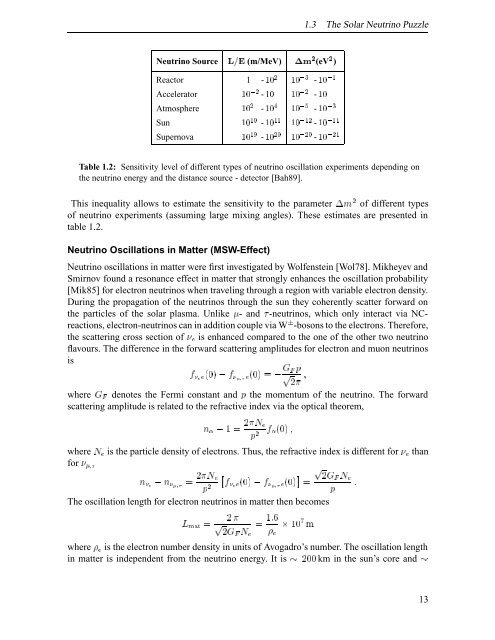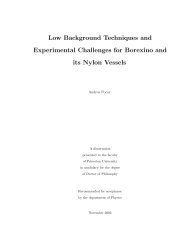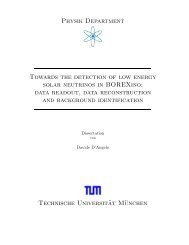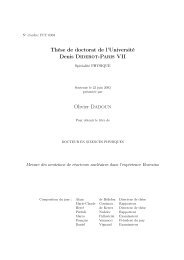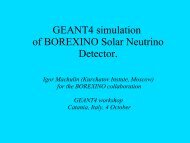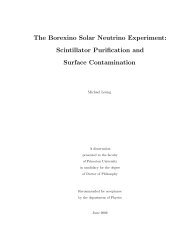Development of a Liquid Scintillator and of Data ... - Borexino - Infn
Development of a Liquid Scintillator and of Data ... - Borexino - Infn
Development of a Liquid Scintillator and of Data ... - Borexino - Infn
Create successful ePaper yourself
Turn your PDF publications into a flip-book with our unique Google optimized e-Paper software.
Neutrino Source Ä (m/MeV) ¡Ñ (eV )<br />
Reactor 1 - -<br />
Accelerator -10 -<br />
Atmosphere - -<br />
Sun - -<br />
Supernova - -<br />
1.3 The Solar Neutrino Puzzle<br />
Table 1.2: Sensitivity level <strong>of</strong> different types <strong>of</strong> neutrino oscillation experiments depending on<br />
the neutrino energy <strong>and</strong> the distance source - detector [Bah89].<br />
This inequality allows to estimate the sensitivity to the parameter ¡Ñ <strong>of</strong> different types<br />
<strong>of</strong> neutrino experiments (assuming large mixing angles). These estimates are presented in<br />
table 1.2.<br />
Neutrino Oscillations in Matter (MSW-Effect)<br />
Neutrino oscillations in matter were first investigated by Wolfenstein [Wol78]. Mikheyev <strong>and</strong><br />
Smirnov found a resonance effect in matter that strongly enhances the oscillation probability<br />
[Mik85] for electron neutrinos when traveling through a region with variable electron density.<br />
During the propagation <strong>of</strong> the neutrinos through the sun they coherently scatter forward on<br />
the particles <strong>of</strong> the solar plasma. Unlike - <strong>and</strong> -neutrinos, which only interact via NCreactions,<br />
electron-neutrinos can in addition couple via W ¦ -bosons to the electrons. Therefore,<br />
the scattering cross section <strong>of</strong> is enhanced compared to the one <strong>of</strong> the other two neutrino<br />
flavours. The difference in the forward scattering amplitudes for electron <strong>and</strong> muon neutrinos<br />
is<br />
Ô<br />
Ô <br />
where denotes the Fermi constant <strong>and</strong> Ô the momentum <strong>of</strong> the neutrino. The forward<br />
scattering amplitude is related to the refractive index via the optical theorem,<br />
Ò« Æ<br />
« <br />
Ô<br />
where Æ is the particle density <strong>of</strong> electrons. Thus, the refractive index is different for than<br />
for <br />
Ò<br />
Ò Æ ¢<br />
<br />
Ô<br />
<br />
£<br />
<br />
Ô<br />
The oscillation length for electron neutrinos in matter then becomes<br />
ÄÑØ <br />
<br />
Ô Æ<br />
<br />
<br />
¢ Ñ<br />
Ô Æ<br />
where is the electron number density in units <strong>of</strong> Avogadro’s number. The oscillation length<br />
in matter is independent from the neutrino energy. It is km in the sun’s core <strong>and</strong> <br />
<br />
13


